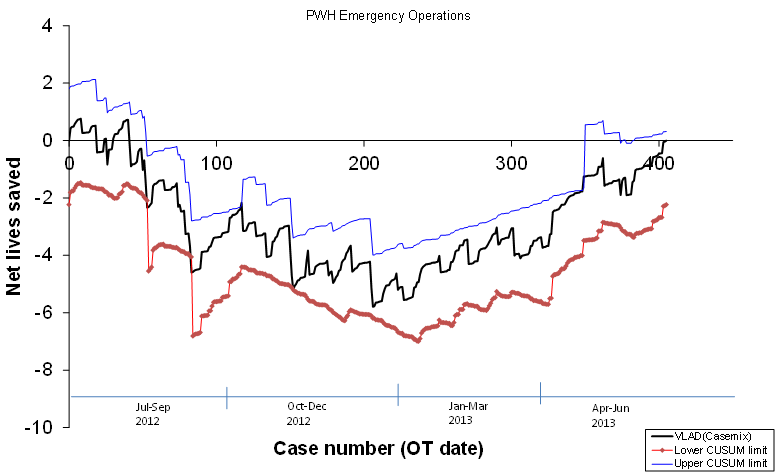 |

Variable life adjusted display (VLAD):
Variable life adjusted display (VLAD) has been widely used in multiple disciplines within the healthcare setting for
clinical outcomes trend presentation, including cardiac surgery.
The ability to pick up downward trends in performance at an early stage in trauma care suggested the VLAD system might
be an answer to an early warning system specifically to surgical outcome quality.
Objective

 |
Risk adjustment model in emergency general surgical
operations is difficult to derive due to a wide variety of diseases, procedures and patient risk profile.
|
 |
In our study we described the use of administrative
data as risk-adjustment model in the VLAD charts to monitor outcome of emergency general surgical operations in the
Prince of Wales Hospital.
|
| Target Teams |
: |
General Teams
- Team 1 : Hepatobillary & Pancreatic Surgery
- Team 2 : Upper Gastro-intestinal Surgery
- Team 3 : Colorectal Surgery
- Team 4 : Vascular Surgery
|
| Case Type |
: |
Emergency
|
| Period |
: |
Beyond July 2013
|
Methodology

 |
We retrieved all emergency operation data
from the SOMIP database for PWH from 1 July 2012 to 30 June 2013.
|
 |
Hospital administrative data were then
retrieved of the corresponding cases:
- diagnosis and procedure codes
- the 3M International Refined Diagnostic Related Group of risk of mortality (ROM) and severity level (SOI)
- Blood test results
|
 |
Risk-adjustment model constructed by
logistic regression.
Upper and lower CUSUM limit corresponding to halve and twice the odds of mortality was set as the boundary of
accepted performance.
|
 |
For VLAD curve fell below this limit,
it served as an "alarm" for action.
|
Emergency Operations

|
 |


